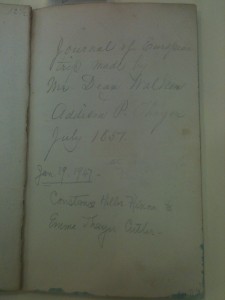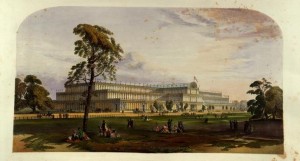In August of 1851, Mr. Dean Walker, a Massachusetts man, visited Liverpool, England for the very first time. His initial impression of the city could be described as underwhelmed:
Saturday [August 2] – I have spent the day in travelling about the town. Find the people looking better than I expected. I do not think there are more dirty shabby looking people here than in New York, or more of the low classes here than there. They do not appear to be employed here, they only come from Ireland to ship to New York and other places. I went to see the “Great Western” start for New York. Those who were going I think were the most dirty-looking people I ever saw. A few ragged people are begging in the streets but not as many as I expected to see.
Liverpool was the first of many stops Walker made in a multiple-month-long “European trip,” during which he visited parts of England, Ireland, Scotland France, and Italy. During his travels, he recorded his initial impressions and quick observations on European life, landscape, and people in a journal.
Walker’s journal is one of several travel journals within the Diary Collection. Travel journals are personal, narrative accounts of an author’s travels – broadly defined here as experiences that involve long or short-distance movement across a geographic space. The four travel journals contained within this collection were all written by Americans traveling through Europe during the late nineteenth century.
Walker, whose age is unknown, lived during a time when travel between the United States and Europe was accelerating – literally. He left Boston bound for Liverpool, England on July 15, 1851 in what was likely the packet ship (or “clipper ship”) Daniel Webster, built and run by the Boston-based Enoch Train & Company line.[1] He arrived in Liverpool after sixteen days of travel on August 1, a “fast passage” according to the Webster’s captain. Clipper ships, the iconic speedy cargo ships of the nineteenth century, are one of several signs of the nineteenth century transportation revolution, alongside railroads and steamships, evident in Walker’s journal.
Though we know little about Walker, we do know that he was likely a man of means, as he was able to afford passage as a “cabin” (or “first class”) passenger during his journey to Liverpool, on a shipping line popularly perceived as “expensive.” [2] As historian Daniel Kilbride notes in his book Being American in Europe (1750 – 1860), even though the cost of trans-Atlantic travel was declining by mid-nineteenth century and many Americans counted themselves amongst the ranks of the “comfortable” middle class, European travel was still a luxury enjoyed only by the wealthiest citizens.[3]
We also know that Walker was not alone in his travels. In fact, I was first drawn to Mr. Walker’s journal because of its suggested co-authorship. The inside cover of its first page reads, “Journal of European trip made by Mr. Dean Walker + Addison P. Thayer (July 1851).” At early points in the journal, when Walker describes his passage to  Europe, he occasionally uses the pronoun “we,” suggesting the presence of a companion; however, he describes most of his experiences using the singular first person pronoun “I.” It isn’t until Walker reaches France, several weeks into his journey, that he mentions: “Mr. Thayer was with me.” Their relationship remains unclear.
Europe, he occasionally uses the pronoun “we,” suggesting the presence of a companion; however, he describes most of his experiences using the singular first person pronoun “I.” It isn’t until Walker reaches France, several weeks into his journey, that he mentions: “Mr. Thayer was with me.” Their relationship remains unclear.
Perhaps this is because Walker is largely concerned with using his journal to discuss other matters. He focuses on describing his new experiences and his impressions of things that seem particularly “curious” to him. He notes seeing “black fish” porpoises and whales during the voyage to Liverpool, seeing his first Hippopotamus at the Zoological Gardens, and taking a meal at the Mechanics Eating House in London – significant to him because he could enjoy a book from their large library with his meal. His interest in using his journal to describe the extraordinary material things he sees is evident from an entry he writes about his visit to the Crystal Palace in London to see the “Great Exhibition of 1851,” a “World’s Fair” housing display of technology:
Tues. [September] 26th: I went today for the third time to the Glass Palace…I thought I would today begin and go through and [write] down the prices and try to give a description of the most curious things I saw, but I directly became discouraged and gave it up as a bad job. The best way I can give one an idea of the things is to describe some of the most extravagant things and some of the most simple, and then have any one form an idea from the size of the building how much was to be seen.
He goes on to describe several extraordinary and expensive objects he sees at the exhibition– a large diamond, expensive furniture. His interest in wealth is telling, as his the suggestion that he may be describing these objects “for someone else.” Unlike Ann Winchester, it seems as if Walker may have had an audience in mind for his diary – perhaps family and friends back home, who would read his journal upon his return.
Walker’s journal is filled with comparisons, as well as descriptions. As evident in the above-quoted passage about the Irish immigrants passing through Liverpool on their way to the United States, Walker frequently compares European people, as well as landscape, architecture, food, and habits to American ones. In a few instances, he also compares his experiences in each European nation he visits to his experiences in other places in Europe. Consider the following excerpt from his journal, in which he describes a train ride he takes on his way from Hull, England to London:
[August, around the 16th]: The land on the rail-road for the most part is well cultivated, but not as neatly as in Ireland. The hedges looked much more uneven – a considerable woodland – the trees not large, and when we were within 10 miles of London it looked more like Massachusetts than it had at any time, on account of the wood.
Some of the comparisons Walker makes are purely descriptive, such as his recognition of the British landscape as very similar to that of Massachusetts. But there are many more that are qualitative in nature, including his comment included above about the “neatness” of British “cultivation.” Walker’s journal is therefore a place where he evaluates the quality of European culture, food, and conditions, by comparing them to the quality of American goods. As a person clearly cognizant of status and quality, this seems consistent with Walker’s character; as an American in Europe for the first time, it may have been Walker’s self-conscious attempt to understand America’s place in the world.
Rebecca D’Angelo is a senior undergraduate student in History and Anthropology. In her blog series For Private Eyes Only she studies diaries available in Archives and Special Collections at the Dodd Research Center to explore the history of journal writing and reasons why we write journals.
[1] The Daily Evening Transcript (Boston, Massachusetts); July 14, 1851, pg. 4.
[2] Boston Semi-Weekly Courier (Boston, Massachusetts), July 17, 1851, pg. 2.
[3] Daniel Kilibride, Being American in Europe, 1750–1860 (Baltimore: The Johns Hopkins University Press) 2013, 83.

